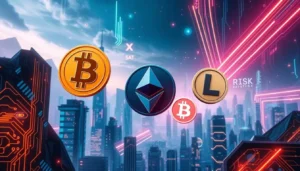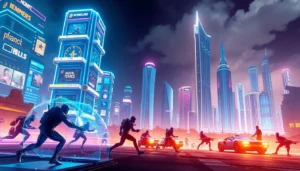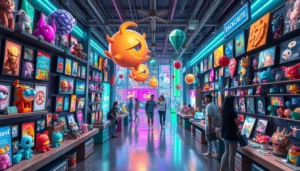The Future of NFTs in 2025 and Beyond: Are NFTs Dead?
Remember when NFTs first burst onto the scene? It felt like a digital gold rush. Artists, collectors, and even everyday people were captivated by the idea of owning unique digital assets. But as the hype faded, many wondered: Are NFTs still relevant?
Today, the conversation is shifting. Instead of just being about art and collectibles, blockchain technology is unlocking new possibilities for NFTs. From real estate to healthcare, these tokens are proving their worth in ways we never imagined.

Take Beeple’s $69 million sale at Christie’s. It wasn’t just a moment for the art world; it was a glimpse into the potential of NFTs. Now, industries are exploring how they can use this technology to solve real-world problems, like verifying ownership or streamlining supply chains.
So, are NFTs dead? Far from it. These digital assets are progressing rapidly, with increasingly promising applications.
Table of Contents
Introduction: Understanding the Evolution of NFTs
What began as pixelated collectibles now drives sophisticated commercial and institutional solutions. These unique tokens started as a niche experiment in the blockchain world but quickly gained traction. Early projects like CryptoPunks introduced the concept of verifiable digital scarcity, paving the way for modern applications.
The ERC-721 protocol fundamentally changed how digital assets are created and managed. It enabled creators to mint one-of-a-kind tokens, ensuring authenticity and ownership. This technology laid the foundation for the digital art boom, where artists could monetize their work like never before.
During the pandemic, NFTs exploded into the mainstream. Collectors and investors flocked to the market, driving prices to unprecedented levels. However, this rapid growth was followed by a correction, reminding everyone of the volatility in this space.
Gaming also saw a significant shift with NFTs. Axie Infinity, a play-to-earn game, reached a $1.3 billion valuation in 2021. This marked a turning point, showing how NFTs could transform in-game assets and economies.
Virtual real estate added another layer to this evolution. Decentraland’s $2.4 million virtual land sale demonstrated the potential of blockchain-based ownership. It also highlighted the challenges of cross-border transactions, especially with evolving regulations.
NFTs are expanding their influence across sectors, altering traditional concepts of possession. Their disruptive potential spans creative industries, interactive media, and enterprise applications.

The Next Era of NFTs: Utility-Driven Applications
NFTs are no longer just about digital art. They’re making waves in gaming and real estate, creating new ways to earn, invest, and own. These industries are leveraging the power of blockchain to redefine how we interact with assets.
NFTs in Gaming: Play-to-Earn and In-Game Assets
Axie Infinity and similar titles have redefined interactive entertainment by merging gaming with decentralized economies. Modern gaming platforms allow users to generate tangible income by participating in skill-based virtual ecosystems. During its peak in 2021, Axie Infinity distributed more than a billion dollars to its global player base. This framework enables players to convert their dedication and expertise into financial rewards.
Yield Guild Games is another example. In the Philippines, programs educate gamers on leveraging blockchain-based assets for sustainable earnings. This approach creates new economic opportunities, especially in developing regions.
The Sandbox has also gained attention. Partnerships with Snoop Dogg and HSBC show how platforms are blending entertainment and investment. Today’s gaming environments grant users unprecedented control over acquiring, exchanging, and profiting from digital items.
NFTs and Real Estate: Tokenizing Property Ownership
NFTs are transforming property markets by introducing fractional and transparent ownership models. Platforms like RealT enable fractional ownership. Fractional property investments are now accessible with entry points as low as $50 per digital share. Democratized investing is now possible, allowing broader participation in high-value markets.
Smart contracts are streamlining property transactions. They automate title transfers, reducing paperwork and errors. Propy’s experiments with NFT-backed mortgages highlight blockchain’s potential to streamline real estate transactions.
Decentraland’s MANA token reached a $6 billion market cap in 2021. Virtual property platforms showcase how blockchain can revolutionize asset ownership and transferability. It also highlights the challenges of cross-border transactions and evolving regulations.
Blockchain-based property registries are gaining traction. While they offer transparency, their environmental impact is a concern. New advancements in low-energy blockchain protocols are mitigating environmental concerns.
NFTs in the Creator Economy: Empowering Artists and Musicians
Creators are finding new ways to connect with their audience through NFTs. These digital tokens are transforming how artists and musicians share their work and build their community. From album sales to exclusive memberships, NFTs are unlocking opportunities that were once out of reach.
Tokenized Experiences and Community Memberships
Kings of Leon made headlines in 2021 by generating $2 million from NFT album sales. This showed how music creators could bypass traditional streaming platforms and connect directly with fans. Similarly, 3LAU’s $11.6 million NFT album sale introduced a new distribution model, where fans could own a piece of the music they love.
Sound.xyz is another innovator in this space. Their listener-owned song royalty system allows fans to earn a share of royalties. This creates a deeper connection between creators and their audience while offering a sustainable income stream.
Gary Vaynerchuk’s Flyfish Club took this concept further. A $14 million NFT-based dining club merges digital scarcity with premium physical perks. It’s a prime example of how tokens can create value beyond the digital realm.
Traditional streaming royalties often leave artists with minimal earnings. NFTs, on the other hand, enable direct patronage. Fans can support their favorite creators while gaining unique benefits, like access to unreleased tracks or private events.
However, challenges remain. OpenSea’s creator royalty enforcement controversies highlight the need for better platforms and policies. Despite this, the potential for NFTs to empower artists and musicians is undeniable.
These digital assets are progressing rapidly, with increasingly promising applications. By embracing blockchain technology, he’s redefining how music labels operate and how artists are compensated.
NFTs are more than just a trend; they’re a tool for creators to take control of their art and build lasting connections with their fans.

NFTs in Healthcare: Revolutionizing Medical Records and Research
Healthcare is undergoing a digital transformation with NFTs. These tokens are now being used to manage medical data, ensuring secure and portable ownership. From patient records to research integrity, blockchain technology is making a significant impact.
BurstIQ’s LifeGraph is a prime example. It manages over 20 million patient records using blockchain. Blockchain-enabled healthcare systems provide tamper-proof records while improving data interoperability. Initiatives like the NIH’s All of Us program are tokenizing health data to accelerate medical discoveries.
Ownership and Portability of Medical Data
Patientory’s PTOY tokens offer HIPAA-compliant solutions for medical data management. These tokens ensure secure ownership and portability, allowing patients to control their health information. Medibloc’s South Korean EHR system handles over 1 million patients, showcasing the scalability of blockchain-based systems.
Pharmaceutical companies are also leveraging NFTs. VeChain’s blockchain monitors the cold chain for vaccines, ensuring integrity from production to delivery. Pfizer used blockchain to maintain the integrity of COVID vaccine trial data, highlighting its potential for research.
Mental health DAOs are another innovative application. They use NFT-based treatment access to provide affordable care. However, the ethical implications of genomic data markets remain a concern. The ongoing challenge lies in fostering technological progress while safeguarding personal privacy.
| Application | Example | Impact |
|---|---|---|
| Patient Records | BurstIQ’s LifeGraph | Secure data management |
| Research Integrity | Pfizer’s COVID trials | Data accuracy |
| Cold Chain Monitoring | VeChain NFTs | Vaccine integrity |
| Mental Health | NFT-based DAOs | Affordable care access |
NFTs in Education: Immutable Certifications and Continuous Skill Development
The education sector is adopting decentralized systems to issue and validate qualifications securely. This shift is empowering individuals to take control of their academic achievements. With verifiable credentials, you can securely share your qualifications across platforms without fear of fraud.
MIT led the way in 2021 by issuing over 100 digital diplomas via Blockcerts. This innovation ensures that your academic records are tamper-proof and easily accessible. Woolf University processed $2 million in tuition via NFT transactions, pioneering blockchain-integrated education. These examples highlight the growing role of blockchain in education.
Blockchain-Powered Alumni Networks
Sony’s learning initiatives now use blockchain technology to securely store and transfer student transcripts, preventing fraud while ensuring easy access. Streamlined credential checks benefit both hiring entities and educational organizations. Similarly, OpenCerts has issued over 500,000 credentials across Singapore’s educational institutions, streamlining the process for students and graduates.
Lambda School has introduced income-sharing agreement NFTs, allowing students to pay tuition after securing work. Platforms like Binance Academy award NFT-based course certifications, enhancing e-learning legitimacy. Coursera is exploring micro-credential tokenization, which could revolutionize how skills are recognized globally.
International credential validation is now faster and more cost-effective thanks to distributed ledger tech. Blockchain reduces costs and eliminates intermediaries, making it easier for individuals to showcase their qualifications worldwide. Blockchain in education isn’t temporary; it’s reshaping how we track and value knowledge acquisition.

NFTs in Everyday Life: From Ticketing to Digital Keys
Envision accessing vehicles or events seamlessly through cryptographic tokens. NFTs are making this possible, blending convenience with security. From ticketing to loyalty programs, these tokens are becoming part of daily routines.
GET Protocol has already issued over 4 million NFT tickets, preventing $28 million in fraud. This shows how blockchain-based ticketing systems can enhance security and streamline access. Similarly, Ticketmaster is testing NFT entry passes for the 2024 Olympics trials, offering a glimpse into the future of event management.
Tokenized Rewards and Loyalty Programs
Starbucks Odyssey has enrolled over 500,000 users in its NFT-based rewards program. This initiative combines gamification with exclusive benefits, creating a new way to engage customers. Hilton Honors has also embraced this trend, with over 1 million NFT reward redemptions.
BMW is replacing physical car fobs with digital key NFTs, offering a seamless and secure way to access vehicles. With its SWOOSH platform, Nike is certifying the authenticity of virtual sneakers, fostering confidence in the buying and selling of digital fashion assets. These innovations highlight how NFTs are reshaping industries.
VeeCon’s NFT-gated conference attracted over 10,000 attendees, proving the value of exclusive digital experiences. Walmart’s supply chain NFT pilot reduced losses by 15%, showcasing the potential of blockchain in logistics. As these examples show, NFTs are more than a trend; they’re a tool for innovation.
Conclusion: The Limitless Potential of NFTs
Blockchain technology is reshaping industries through NFTs. From healthcare to education, these tokens are solving real-world problems. Ethereum’s Merge update has addressed energy concerns, making NFTs more sustainable. Emerging markets are leapfrogging traditional systems, adopting blockchain solutions faster than ever.
Regulatory frameworks are evolving to classify NFT securities, ensuring safer investments. AI integration is enhancing content authentication, adding another layer of utility. While speculative bubbles remain a risk, utility-focused projects are gaining traction.
Explore how NFTs can transform your field. Whether it’s verifying ownership or streamlining processes, their potential is limitless. Global adoption of this technology is accelerating The time to engage.







